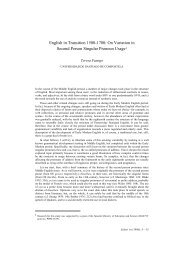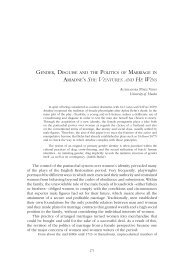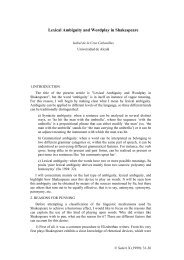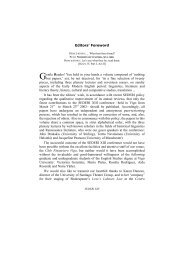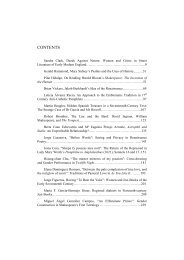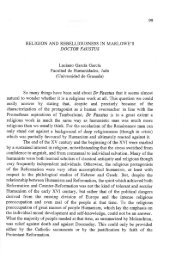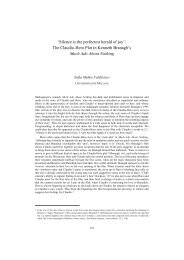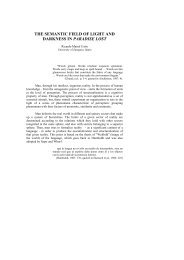Spelling standardisation in Shakespeare's first editions: - Dialnet
Spelling standardisation in Shakespeare's first editions: - Dialnet
Spelling standardisation in Shakespeare's first editions: - Dialnet
Create successful ePaper yourself
Turn your PDF publications into a flip-book with our unique Google optimized e-Paper software.
<strong>Spell<strong>in</strong>g</strong> <strong>standardisation</strong><br />
<strong>in</strong> Shakespeare’s <strong>first</strong> <strong>editions</strong>:<br />
evidence from the Second Quarto<br />
and First Folio versions of Romeo and Juliet<br />
Rita QUEIROZ DE BARROS<br />
University of Lisbon<br />
ABSTRACT<br />
This paper presents a study on spell<strong>in</strong>g <strong>standardisation</strong> <strong>in</strong><br />
Shakespeare’s <strong>first</strong> <strong>editions</strong>. Though certa<strong>in</strong>ly not central <strong>in</strong> literature,<br />
<strong>in</strong> which the orthography of Shakespeare’s texts has been considered<br />
ma<strong>in</strong>ly as an authorial and chronological test or as a tool for textual<br />
or phonological reconstruction, this issue deserves attention. An<br />
appraisal of the degree of spell<strong>in</strong>g <strong>standardisation</strong> <strong>in</strong> Shakespeare’s<br />
<strong>first</strong> <strong>editions</strong>, which we know <strong>in</strong>complete, may (i) contribute to a<br />
description of the <strong>standardisation</strong> of the English spell<strong>in</strong>g system,<br />
generally allocated to the Early Modern period but still present<strong>in</strong>g<br />
important lacunae; (ii) provide a better knowledge of the spell<strong>in</strong>g<br />
habits and variation patterns <strong>in</strong> Shakespeare’s <strong>first</strong> <strong>editions</strong>, thereby<br />
lessen<strong>in</strong>g the difficulties <strong>in</strong>volved <strong>in</strong> the use of digital versions of<br />
those texts; (iii) supply a background aga<strong>in</strong>st which to appraise the<br />
alleged manipulation of spell<strong>in</strong>g for stylistic purposes <strong>in</strong> the<br />
Renaissance period, namely the use of visual rhymes and of spell<strong>in</strong>g<br />
variants.<br />
Assum<strong>in</strong>g <strong>standardisation</strong> as a trend towards uniformity, this<br />
analysis concentrates on two different Renaissance <strong>editions</strong> of Romeo<br />
and Juliet and identifies a significant degree of orthographic<br />
regularity <strong>in</strong> the corpus considered, thus contradict<strong>in</strong>g expectations<br />
raised by most references so far.<br />
KEYWORDS: spell<strong>in</strong>g, <strong>standardisation</strong>, Shakespeare, l<strong>in</strong>guistic<br />
variation, Early Modern English<br />
1. Introduction<br />
Though not central <strong>in</strong> either historical l<strong>in</strong>guistics or Shakespearean<br />
studies, which tend to assume orthography merely as a means to<br />
register speech, spell<strong>in</strong>g and its <strong>standardisation</strong> are certa<strong>in</strong>ly not<br />
new to these research areas.<br />
Sederi 17 (2007: pp. 93-108)
Sederi 17 (2007)<br />
In fact, as evidence required for language reconstruction, past<br />
spell<strong>in</strong>g practices have been treated <strong>in</strong> literature s<strong>in</strong>ce the advent of<br />
English philology; furthermore, as Gómez Soliño stresses (1985a: 81),<br />
the ris<strong>in</strong>g of Standard English is a classic issue <strong>in</strong> the history of the<br />
language, and so far the approach to this question has privileged<br />
writ<strong>in</strong>g and, <strong>in</strong> particular, spell<strong>in</strong>g (Rissanen 1999: 134, Wright 2000:<br />
2).<br />
With<strong>in</strong> Shakespearean studies, spell<strong>in</strong>g has been considered<br />
not only for purposes of textual reconstruction (e.g.: H<strong>in</strong>man 1963),<br />
as an authorial and chronological test (as suggested and mentioned<br />
by Pollard 1923), and as a tool for phonological reconstruction (e.g.:<br />
Cercignani 1981), but also, though less frequently, described for its<br />
own sake (e.g.: Partridge 1954, 1964; Blake 2002); and such allusions<br />
make it very clear that the spell<strong>in</strong>g of Shakespeare’s <strong>first</strong> <strong>editions</strong><br />
was far from uniform. As is well known, even the First Folio, which<br />
is the product of a fairly careful enterprise by Hem<strong>in</strong>g and Condell,<br />
was found to be set <strong>in</strong> pr<strong>in</strong>t by at least five compositors impos<strong>in</strong>g on<br />
the text different spell<strong>in</strong>g systems (Blake 2002: 7). Charlton H<strong>in</strong>man<br />
has shown, for <strong>in</strong>stance, that what he identifies as compositor A<br />
preferred the spell<strong>in</strong>gs doe, goe, here, griefe, traytor, young, Ulisses or<br />
Troian, while the so-called compositor B preferred the forms do, go,<br />
heere, greefe, traitor, yong, Ulysses and Troyan.<br />
In spite of this background, spell<strong>in</strong>g <strong>standardisation</strong> and its<br />
status <strong>in</strong> Shakespeare’s <strong>first</strong> <strong>editions</strong> seem to deserve further<br />
<strong>in</strong>vestigation. In the <strong>first</strong> place, because descriptions of both the<br />
history of English spell<strong>in</strong>g and of the <strong>standardisation</strong> of the<br />
language, of which orthographic regularisation is part and symptom,<br />
still present important lacunae.<br />
In fact, despite diffuse treatment of orthography <strong>in</strong> traditional<br />
literature, references on the history of some graphemes (e.g.: Grosse<br />
1937), various and important work on the spell<strong>in</strong>g of particular<br />
words (e.g.: The Oxford English Dictionary; H<strong>in</strong>man 1948), authors<br />
(e.g.: Byrne 1923, Partridge 1964, Samuels 1988 [1983], Diemer 1998),<br />
pr<strong>in</strong>ters (e.g.: Fisher 1996 [1984], Aronoff 1989, Gómez Soliño 1985b,<br />
Salmon 1989), texts (e.g.: Partridge 1954; McLaughl<strong>in</strong> 1963, Blake<br />
1965, Rutkowska 2000) and dialects (e.g.: Fisher 1996 [1977], 1979;<br />
McIntosh, Samuels and Bensk<strong>in</strong> eds. 1986), and even three books<br />
especially dedicated to the history of English spell<strong>in</strong>g (Vall<strong>in</strong>s 1954,<br />
Scragg 1974, Bourcier 1978), approaches to the subject have been too<br />
circumscribed and/or flawed by the urge to justify the eccentric<br />
relationship between writ<strong>in</strong>g and speech <strong>in</strong> English (e.g.: Craigie<br />
94
Sederi 17 (2007)<br />
1927, Vall<strong>in</strong>s 1954), the <strong>in</strong>strumental value of spell<strong>in</strong>g for<br />
phonological reconstruction (e.g.: Jespersen 1909) and the reign<strong>in</strong>g<br />
lack of <strong>in</strong>terest <strong>in</strong> writ<strong>in</strong>g s<strong>in</strong>ce Saussurean times (e.g.: Scragg 1974).<br />
The need for a new history of English orthography has even been<br />
explicitly stated by Bliss (1975: 511) and, more recently, Görlach<br />
(1995: 5). 1<br />
The same can be said of the <strong>standardisation</strong> of English. Despite<br />
strong renewed <strong>in</strong>terest on the subject (cf. for <strong>in</strong>stance Gómez Soliño<br />
1984 and Wright ed. 2000), recent research has not yet been able to<br />
compensate for the traditional focus on the sources of Standard<br />
English, a still ongo<strong>in</strong>g debate, and, <strong>in</strong> particular, for the apparent<br />
acceptance of the emergence of that variety as a l<strong>in</strong>ear process tak<strong>in</strong>g<br />
place <strong>in</strong> the Early Modern (henceforward EMod) period. 2<br />
As a consequence of the lacunae identified <strong>in</strong> previous<br />
paragraphs, the description of the <strong>standardisation</strong> of English<br />
orthography is still very <strong>in</strong>complete. In fact, the exact characteristics<br />
of the system that turned standard are not known for sure and tend<br />
to be confused with the present ones; different op<strong>in</strong>ions on those<br />
responsible for its emergence as a model – i.e. pr<strong>in</strong>ters or l<strong>in</strong>guistic<br />
authorities – still rema<strong>in</strong>; the standard spell<strong>in</strong>g’s diffusion along<br />
geographical, sociol<strong>in</strong>guistic and stylistic cont<strong>in</strong>ua is largely to map;<br />
and last but not least, a contradictory chronology is attributed to that<br />
phenomenon. In fact, a search for this apparently simple piece of<br />
<strong>in</strong>formation <strong>in</strong> literature reveals that, though generally situated <strong>in</strong><br />
Early Modern English (henceforward EModE), different references<br />
situate the <strong>standardisation</strong> of English orthography at different<br />
moments of that period; and some authors even give different dates<br />
for its occurrence <strong>in</strong> the very same text. That is the conclusion we can<br />
draw from the table below, which summarizes <strong>in</strong>formation collected<br />
from various sources: 3<br />
1 In fact, Scragg (1974), still the most comprehensive reference on the history of<br />
English spell<strong>in</strong>g, concentrates on the external history of its subject, which has given<br />
rise to severe criticism <strong>in</strong> literature, namely by Bliss (1975) and Salmon (1976).<br />
For a thorough appraisal of the histories of English spell<strong>in</strong>g see Kniezsa (1992).<br />
2 Cf. Wright, 1996 and 2000, for a discussion of the issues <strong>in</strong>volved <strong>in</strong> the description<br />
of the <strong>standardisation</strong> of English and their unsatisfactory treatment <strong>in</strong> literature.<br />
3 Italics mark references present<strong>in</strong>g contradictory <strong>in</strong>formation on the chronology of<br />
spell<strong>in</strong>g <strong>standardisation</strong>.<br />
95
15th century<br />
Orcutt (1929:<br />
39)<br />
Bühler (1960:<br />
5)<br />
Pei (1967: 50)<br />
Sederi 17 (2007)<br />
16th century<br />
17th century<br />
early middle late<br />
Fernández<br />
(1993: 87)<br />
Scragg (1974:<br />
55)<br />
Potter (1950: 71)<br />
Partridge (1964: 2)<br />
Scragg (1974: 68)<br />
Brengelman (1980:<br />
334)<br />
Görlach (1991: 48)<br />
Knowles (1997: 102)<br />
Salmon (1999: 32)<br />
Table 1. Chronology of spell<strong>in</strong>g <strong>standardisation</strong><br />
Scragg (1974:<br />
80)<br />
Görlach (1991:<br />
46)<br />
Blake (1996:<br />
11)<br />
Knowles (1997:<br />
124)<br />
18th century<br />
Vall<strong>in</strong>s (1954: 7,<br />
16)<br />
Strang (1970:<br />
107)<br />
Bourcier (1978:<br />
129)<br />
Leith (1983: 34)<br />
Freeborn (1992:<br />
196)<br />
As evidenced by the table, the time-span referred to is long.<br />
And though the <strong>in</strong>clusion of the fifteenth century is no longer a valid<br />
suggestion but a mere service to exhaustiveness, we are left with<br />
three centuries as possible moments for the <strong>standardisation</strong> of<br />
English spell<strong>in</strong>g. This is surely a symptom of the need for further<br />
research, which is particularly true as far as descriptions of the<br />
spell<strong>in</strong>g praxis are concerned, both <strong>in</strong> manuscript texts, for more<br />
obvious reasons, and <strong>in</strong> pr<strong>in</strong>ted ones. 4<br />
That is probably why we can f<strong>in</strong>d recent research on or<br />
connected to the subject, namely by Gómez Soliño (<strong>in</strong> particular<br />
1981, 1984, 1986), Sönmez (1993), Rodríguez (1999), Hérnandez-<br />
Campoy and Conde Silvestre (1999), Conde Silvestre, Hernández-<br />
Campoy and Pérez Salazar (2000) and Taavitsa<strong>in</strong>en (2000). Gómez<br />
Soliño analyses the vertical diffusion of the emerg<strong>in</strong>g standard <strong>in</strong><br />
pr<strong>in</strong>ted and manuscript texts produced from 1470 to 1540; Sönmez<br />
assesses spell<strong>in</strong>g <strong>standardisation</strong> <strong>in</strong> late seventeenth century as<br />
shown <strong>in</strong> manuscript and pr<strong>in</strong>ted texts by the same author;<br />
Rodríguez observes the extension of written practices of the<br />
Chancery to private correspondence written <strong>in</strong> the late fifteenth<br />
century (part of the Paston Letters); Hérnandez-Campoy, Conde<br />
Silvestre and Pérez Salazar develop similar work on some of the<br />
Cely, Paston and Stonor Letters, dated from 1424 to 1490, and try to<br />
4 In her recent chapter on EModE spell<strong>in</strong>g and punctuation <strong>in</strong>cluded <strong>in</strong> The Cambridge<br />
History of the English Language, Salmon susta<strong>in</strong>s that “there is (…) no (…) detailed<br />
account of the gradual <strong>in</strong>troduction of standard spell<strong>in</strong>g <strong>in</strong> pr<strong>in</strong>ted books” (1999: 55).<br />
96
Sederi 17 (2007)<br />
map the social diffusion of written variants typical of Chancery<br />
English; and f<strong>in</strong>ally Taavitsa<strong>in</strong>en observes the extension of Chancery<br />
and Central Midland spell<strong>in</strong>g practices to medical texts written from<br />
1375 to 1550.<br />
Despite their undeniable importance for the study of spell<strong>in</strong>g<br />
<strong>standardisation</strong>, the references just mentioned are not enough. Most<br />
of them limit themselves to only a few variables; 5 and all of them<br />
concentrate on either the beg<strong>in</strong>n<strong>in</strong>g or the end of the EMod period<br />
and never consider its central decades, which may have played a<br />
crucial role <strong>in</strong> the <strong>standardisation</strong> of English spell<strong>in</strong>g. This is one of<br />
the reasons to consider Shakespeare’s <strong>first</strong> <strong>editions</strong> <strong>in</strong> the particular<br />
perspective of spell<strong>in</strong>g <strong>standardisation</strong> – those texts are certa<strong>in</strong>ly an<br />
important sample of the pr<strong>in</strong>ted production of those times.<br />
But lacunae <strong>in</strong> the description of the history of English<br />
orthography and <strong>standardisation</strong> are not the s<strong>in</strong>gle motives to<br />
engage <strong>in</strong> a study on spell<strong>in</strong>g regularisation. A second and no less<br />
central reason is the importance acquired by past spell<strong>in</strong>g practices<br />
with the advent of electronic textual reproduction and analysis. In<br />
fact, access to orig<strong>in</strong>al spell<strong>in</strong>g <strong>editions</strong>, which are certa<strong>in</strong>ly to prefer,<br />
has become widespread; but so have automatic searches on such<br />
corpora, which are, almost fatally, based on graphic forms. Historical<br />
orthography has therefore ceased to be the <strong>in</strong>terest of the specialist<br />
alone and turned <strong>in</strong>to a tool required by all those who no longer<br />
dispense with electronic aids for their analysis of textual material:<br />
they have to be aware of the patterns and variation tendencies they<br />
can encounter. An appraisal of the degree of spell<strong>in</strong>g <strong>standardisation</strong><br />
<strong>in</strong> Shakespeare’s <strong>first</strong> <strong>editions</strong> will therefore lessen the difficulties<br />
<strong>in</strong>volved <strong>in</strong> the use of the “more orig<strong>in</strong>al” versions of such<br />
fundamental texts.<br />
Last but not least, such a study may supply a background<br />
aga<strong>in</strong>st which to assess the alleged manipulation of spell<strong>in</strong>g for<br />
stylistic purposes <strong>in</strong> the Renaissance period. This is a tendency<br />
mentioned <strong>in</strong> some references, namely the use of visual rhymes<br />
(Wrenn 1943: 34ff) and the resource to spell<strong>in</strong>g variants as a means<br />
5<br />
Gómez Soliño, Conde Silvestre et al. and Taavitsa<strong>in</strong>en consider the graphic<br />
representation(s) of a limited set of words (ca. twenty), chosen because of their use <strong>in</strong><br />
the LALME (Language Atlas of Late Medieval English); Rodríguez considers a similar<br />
sample of functional and lexical words, to which she adds some morphemes and<br />
grapheme clusters; the most detailed analysis is Sönmez’s, which contemplates bound<br />
morphemes, graphemes and some other graphical devices (i.e. apostrophe, hyphen,<br />
capitalization, macron, paragraph, blank space, abbreviation, etc.).<br />
97
Sederi 17 (2007)<br />
to enact the metamorphic style then <strong>in</strong> vogue (Adamson 1999: 555).<br />
But both claims seem at least problematic: the concept of visual<br />
rhymes appears to <strong>in</strong>volve that of a fixed orthography, which is far<br />
from certa<strong>in</strong> <strong>in</strong> EModE; and the deliberate resource to graphic<br />
variants for stylistic reasons implies the existence of standard<br />
spell<strong>in</strong>g patterns, which are still to identify.<br />
S<strong>in</strong>ce they were devoted to stat<strong>in</strong>g the motives to consider<br />
spell<strong>in</strong>g <strong>standardisation</strong> <strong>in</strong> Shakespeare’s texts, previous paragraphs<br />
were not clear as to what is meant by <strong>standardisation</strong>. In this article, it<br />
is understood as the process result<strong>in</strong>g <strong>in</strong> the implementation of a<br />
l<strong>in</strong>guistic standard, conceived as a “written variety vary<strong>in</strong>g<br />
m<strong>in</strong>imally <strong>in</strong> form and maximally <strong>in</strong> function, whose norms are<br />
codified <strong>in</strong> grammars and dictionaries” (Kytö and Roma<strong>in</strong>e 2000:<br />
189).<br />
In the particular plan of spell<strong>in</strong>g, and s<strong>in</strong>ce there were already<br />
prescriptive <strong>in</strong>struments <strong>in</strong> EModE – not only spell<strong>in</strong>g books but<br />
also a major reference like Mulcaster’s Elementarie (1582) –, the study<br />
of spell<strong>in</strong>g <strong>standardisation</strong> <strong>in</strong> Shakespeare’s texts seems to require<br />
the contemplation of the follow<strong>in</strong>g aspects of their orthography:<br />
(i) its degree of uniformity and/or variation;<br />
(ii) its conformity to potential coeval models;<br />
(iii) its similarity to the present spell<strong>in</strong>g of English; and<br />
(iv)<br />
f<strong>in</strong>ally<br />
the possible <strong>in</strong>clusion of future regionalisms that still<br />
permeate some sixteenth century texts. 6<br />
Consider<strong>in</strong>g all these issues at once would be too demand<strong>in</strong>g.<br />
Po<strong>in</strong>ts (i) and (iii) seem most urgent, as their results can be of service<br />
to the use of digital versions of Shakespeare’s <strong>first</strong> <strong>editions</strong>. So, and<br />
given the existence of spread <strong>in</strong>formation and a concise description<br />
of the most important differences between the present spell<strong>in</strong>g and<br />
that of Shakespeare’s time by Blake (2002: 30-33), this article focuses<br />
on the degree of spell<strong>in</strong>g uniformity and/or variation <strong>in</strong> those texts.<br />
This aim will be approached via an electronically supported<br />
quantitative study. Its precise goal is to determ<strong>in</strong>e the relative<br />
weight of words with variant and <strong>in</strong>variant spell<strong>in</strong>g <strong>in</strong> Shakespeare’s<br />
<strong>first</strong> <strong>editions</strong>. Though a simple way of assess<strong>in</strong>g spell<strong>in</strong>g<br />
<strong>standardisation</strong>, it is also an expectedly effective one (Görlach 1999:<br />
4).<br />
6 This tendency was empirically attested by Gómez Soliño <strong>in</strong> research mentioned<br />
above (e.g. 1981).<br />
98
Sederi 17 (2007)<br />
2. Corpus<br />
The corpus considered <strong>in</strong> this study is a sample of Shakespeare’s <strong>first</strong><br />
<strong>editions</strong>, s<strong>in</strong>ce it would be impossible, and <strong>in</strong>deed unnecessary, to<br />
attend to all of them. It is composed of two Renaissance <strong>editions</strong> of<br />
Romeo and Juliet, namely (i) a copy of the Second Quarto, dated 1599,<br />
and (ii) a copy of the First Folio, published <strong>in</strong> 1623. Both these texts<br />
were collected <strong>in</strong> digital format from the site of the Internet<br />
Shakespeare Editions, prepared and ma<strong>in</strong>ta<strong>in</strong>ed by the University of<br />
Victoria, Canada. They were transferred <strong>in</strong>to word processor<br />
documents by means of a simple copy and paste procedure. S<strong>in</strong>ce<br />
the Internet Shakespeare Editions present each scene of each version<br />
separately, such sections were selected one by one <strong>in</strong> the orig<strong>in</strong>al<br />
files, and then pasted <strong>in</strong>to two documents, one per version. The f<strong>in</strong>al<br />
documents were saved as simple text files, the format required by<br />
the analytical software adopted, namely Mike Scott’s Wordsmith<br />
Tools.<br />
The choice of this sample from the extensive list of<br />
Shakespeare’s writ<strong>in</strong>gs was not random. It seemed advisable to<br />
avoid a poem, s<strong>in</strong>ce spell<strong>in</strong>g may be too constra<strong>in</strong>ed by stylistic<br />
factors <strong>in</strong> poetry; 7 and with<strong>in</strong> plays, Romeo and Juliet seems to present<br />
some advantages. In fact, it <strong>in</strong>cludes various styles – rhymed verse,<br />
blank verse and prose; it presents a medium length (990 l<strong>in</strong>es); it is<br />
available, <strong>in</strong> the source mentioned, <strong>in</strong> various EMod <strong>editions</strong>,<br />
thereby provid<strong>in</strong>g evidence also on the chronological progress of<br />
spell<strong>in</strong>g <strong>standardisation</strong>; and, f<strong>in</strong>ally, it was pr<strong>in</strong>ted <strong>in</strong> both one<br />
(Second Quarto) and two (First Folio) columns, thus allow<strong>in</strong>g for a<br />
control of the alleged <strong>in</strong>crease of spell<strong>in</strong>g variation <strong>in</strong> double column<br />
7 This possibility is explicitly mentioned by Puttenham <strong>in</strong> The Arte of English Poesie (Bk.<br />
III, Ch. 1, apud Blake 1996: 230-232):<br />
A Word as he lieth <strong>in</strong> course of language is many wayes figured and thereby<br />
not a little altered <strong>in</strong> sound, which consequently alters the tune and harmonie<br />
of a meeter as to the eare. And this alteration is sometimes by add<strong>in</strong>g<br />
sometimes by rabbat<strong>in</strong>g of a sillable or letter to or from a word either <strong>in</strong> the<br />
beg<strong>in</strong>n<strong>in</strong>g, middle and end<strong>in</strong>g ioyn<strong>in</strong>g or vnioyn<strong>in</strong>g of sillables and letters<br />
suppress<strong>in</strong>g or confound<strong>in</strong>g their seueral soundes, or by misplac<strong>in</strong>g of a letter,<br />
or by cleare exchaunge of one letter for another, or by wrong rang<strong>in</strong>g of the<br />
accent. [...] These many wayes may our maker alter his wordes, and<br />
sometimes it is done for pleasure to give a better sound, sometimes vpon<br />
necessitie, and to make vp the rime. But our maker must take heed thet he be<br />
not to bold specially <strong>in</strong> exchange of one letter for another, for vnlesse vsuall<br />
speach and custome allow it, it is a fault and no figure.<br />
99
Sederi 17 (2007)<br />
texts due to an also double need of l<strong>in</strong>e-justification (Pollard 1923: 5-<br />
6).<br />
The two texts considered amount to a total of 50,270 words –<br />
25,234 from the Second Quarto and 25,036 from the First Folio.<br />
3. Methodology<br />
This study <strong>in</strong>tends to assess spell<strong>in</strong>g <strong>standardisation</strong> <strong>in</strong> Renaissance<br />
<strong>editions</strong> of Shakespeare’s works by determ<strong>in</strong><strong>in</strong>g the relative weight<br />
of graphic words with variant and <strong>in</strong>variant spell<strong>in</strong>g <strong>in</strong> a sample of<br />
those texts.<br />
But the choice of the graphic word as the basic unit for<br />
analysis is not self-evident: English is known to use a mixed spell<strong>in</strong>g<br />
system, <strong>in</strong> which graphic units represent either phonemes,<br />
morphemes or words. For <strong>in</strong>stance, the letter regularly stands<br />
for the diphthong [ei] (e.g. lady) or the vowel [æ] (e.g. lad); but the<br />
sequence at the end of verbal forms represents the preterite<br />
morpheme, variously pronounced as [d] as <strong>in</strong> mowed, [t] as <strong>in</strong> packed<br />
or [id] as <strong>in</strong> started; and knight is a graphic form not obviously<br />
divisible <strong>in</strong>to shorter units and that should be considered as a whole<br />
represent<strong>in</strong>g a lexical item. In Aronoff’s words (1989: 96),<br />
A competent modern English speller must be aware of <strong>in</strong>dividual<br />
sounds, <strong>in</strong>dividual words (<strong>in</strong>asmuch as a majority of common words<br />
have peculiar spell<strong>in</strong>gs), <strong>in</strong>dividual morphemes (the spell<strong>in</strong>g of most<br />
affixes is morphologically determ<strong>in</strong>ed), classes of sounds (mostly <strong>in</strong><br />
the use of silent e and consonant doubl<strong>in</strong>g to mark differences <strong>in</strong><br />
vowel length and stress) and classes of words (especially those which<br />
are related by morphophonological rules).<br />
This type of writ<strong>in</strong>g system was, accord<strong>in</strong>g to the same author,<br />
already <strong>in</strong> existence by the time of Wynkyn de Worde, the famous<br />
second generation pr<strong>in</strong>ter who died ca. 1534. A study of EModE<br />
spell<strong>in</strong>g contemplat<strong>in</strong>g simply words is therefore <strong>in</strong>complete from<br />
the start.<br />
However, alternative choices would be unwise: consider<strong>in</strong>g<br />
phonemes would imply phonological reconstructions requir<strong>in</strong>g<br />
decisions that would largely surpass the scope of this research; and<br />
tak<strong>in</strong>g <strong>in</strong>to account morphemes would <strong>in</strong>volve the segmentation of<br />
complex lexical items, which would be unnecessarily timeconsum<strong>in</strong>g.<br />
The graphic word seemed therefore to be the best<br />
100
Sederi 17 (2007)<br />
variable to attend to and so it is the object of the study described<br />
below. 8 The analysis of the two versions considered, which were<br />
always treated as autonomous texts, proceeded along the five<br />
follow<strong>in</strong>g steps:<br />
(i) Generation of a list of all the graphic forms <strong>in</strong> each text. This was<br />
produced automatically, namely by the WordList program <strong>in</strong>cluded<br />
<strong>in</strong> Wordsmith Tools.<br />
(ii) Edition of the word list mentioned above, from which had to be<br />
excluded several items <strong>in</strong>itially identified by Wordsmith Tools. Such<br />
exclusions are composed of the follow<strong>in</strong>g items:<br />
(a) Forms appear<strong>in</strong>g only once <strong>in</strong> the text and with no<br />
identified variant, s<strong>in</strong>ce they were <strong>in</strong>valid evidence for a study on<br />
spell<strong>in</strong>g uniformity – e.g. accident.<br />
(b) Proper names, which were excluded because of their wellknown<br />
spell<strong>in</strong>g variability <strong>in</strong> EModE, as seems to have happened<br />
with Shakespeare’s name itself – e.g. Romeo.<br />
(c) Abbreviations. These correspond <strong>in</strong> most cases to<br />
characters’ names, but <strong>in</strong>clude other sporadic elements – e.g. Iul, for<br />
Juliet; coz, for cous<strong>in</strong>.<br />
(d) Interjections, given their onomatopaic roots – e.g. ah, o.<br />
(e) A few foreign words used <strong>in</strong> the text – e.g. passado.<br />
(f) Obvious mispr<strong>in</strong>ts, i.e. graphic forms po<strong>in</strong>t<strong>in</strong>g to a<br />
pronunciation which we know for sure did not exist at that time –<br />
e.g. couragi.<br />
(g) Items graphically represented as one word <strong>in</strong> the corpus<br />
but correspond<strong>in</strong>g to separate Present English (henceforward PresE)<br />
words. The major reason for their exclusion is that it was impossible<br />
to control the use of multiword variants of the same element.<br />
Possible examples are yfaith and almaner.<br />
(h) Incomplete words appear<strong>in</strong>g <strong>in</strong> different l<strong>in</strong>es but<br />
assembled by a hyphen <strong>in</strong> the orig<strong>in</strong>al. The reason for this exclusion<br />
was the fact that Wordsmith Tools <strong>in</strong>terpret them as separate words –<br />
e.g.: daugh and ters from daugh-/ters.<br />
(i) Problematic graphic forms known to represent different<br />
PresE words accord<strong>in</strong>g to respectable references. The forms <strong>in</strong><br />
8 It should be stressed that the choice of the word as the basic unit for an analysis of<br />
English orthography is supported by past research – not only by random studies on<br />
historical orthography (e.g. Aronoff 1989, Goméz Soliño 1997, Diemer 1998, Rodríguez<br />
1999, Conde Silvestre et al. 2000), but also by one of the most important descriptions of<br />
the PresE writ<strong>in</strong>g system, i.e. Carney (1994).<br />
101
Sederi 17 (2007)<br />
question are: I, because it could represent either the personal<br />
pronoun or yes; a, which represented both the <strong>in</strong>def<strong>in</strong>ite article and<br />
the weak form of the personal pronoun he; and f<strong>in</strong>ally to and too and<br />
of and off, still undist<strong>in</strong>guished.<br />
This long list of categories of excluded graphic forms<br />
obviously led to an important reduction of the material considered.<br />
The impact of such a reduction can be appreciated <strong>in</strong> the follow<strong>in</strong>g<br />
table, which presents the number of words and graphic forms<br />
orig<strong>in</strong>ally conta<strong>in</strong>ed by each text and those that were kept for<br />
analysis.<br />
Edition<br />
Words<br />
Graphic Forms<br />
Orig<strong>in</strong>al Kept Orig<strong>in</strong>al Kept<br />
Second Quarto 25,234 20,481 4,082 1,916<br />
First Folio 25,036 19,222 3,973 1,845<br />
Table 2. Number of words and graphic forms identified and kept for analysis<br />
(iii) Preparation of a database, <strong>in</strong> Microsoft Excel, <strong>in</strong>clud<strong>in</strong>g the<br />
graphic forms from orig<strong>in</strong>als kept for research, their absolute<br />
frequency and their PresE equivalent. The PresE equivalent was<br />
added because it could be used as a tool to automatically assemble<br />
and count the different graphic forms of the same word by means of<br />
Excel Sort and Subtotals functions. Supply<strong>in</strong>g such an equivalent was<br />
however not always an easy task, s<strong>in</strong>ce some words were difficult to<br />
<strong>in</strong>terpret. Whenever <strong>in</strong> doubt, the Oxford edition of the play was<br />
consulted.<br />
(iv) Identification of the number of graphic variants per word with<br />
the help of Excel Sort and Subtotals functions.<br />
(v) Retrieval of quantitative <strong>in</strong>formation from the database by means<br />
of Excel’s Automatic Filters.<br />
4. Conclusions<br />
Information result<strong>in</strong>g from the analytical steps described above is<br />
summarized <strong>in</strong> Table 3 below. It presents the distribution of words<br />
<strong>in</strong> the two <strong>editions</strong> of Romeo and Juliet considered <strong>in</strong> the study per<br />
number of spell<strong>in</strong>g variants:<br />
102
Sederi 17 (2007)<br />
Number of<br />
Second Quarto (1599) First Folio (1623)<br />
spell<strong>in</strong>g<br />
variants<br />
fi 9 fri (%) 10 e.g. fi fri (%) e.g.<br />
1 1237 79,1 aboord 1300 83,2 abbey<br />
2 306 19,6 chãber, chamber 243 15,6<br />
aduanced,<br />
aduan'st<br />
3 18 1,2<br />
musick, musicke,<br />
musique<br />
17 1,1<br />
4 2 0,1<br />
appothacarie,<br />
appothecarie,<br />
apothecary,<br />
pothecarie<br />
2 0,1<br />
5 1 0,1<br />
cosen, cous<strong>in</strong>,<br />
couzen, cozen, coz<strong>in</strong><br />
Total 1564 100 1562 100<br />
Table 3. Distribution of words per number of spell<strong>in</strong>g variants<br />
--- --- ---<br />
deule, deu'le,<br />
diuell (PresE<br />
devil)<br />
daew, deaw,<br />
dew, dewe<br />
These data allow for some comments and conclusions.<br />
In the <strong>first</strong> place, results on the Quarto (1599) and Folio (1623)<br />
<strong>editions</strong> are extremely similar. Despite a lexical item with a total of 5<br />
spell<strong>in</strong>g variants only <strong>in</strong> the 1599 edition, numbers are quite alike <strong>in</strong><br />
all cells. This implies that:<br />
(i) The <strong>first</strong> quarter of the seventeenth century has played only a<br />
m<strong>in</strong>or role <strong>in</strong> spell<strong>in</strong>g <strong>standardisation</strong>.<br />
(ii) Unlike suggestions made <strong>in</strong> literature, two column pages, as<br />
those of the First Folio, are not a necessary cause for spell<strong>in</strong>g<br />
variation with<strong>in</strong> the same text, despite their stronger demand for<br />
l<strong>in</strong>e-justification. This does not mean that text layout is without<br />
consequences for spell<strong>in</strong>g - the two column First Folio makes a much<br />
more frequent use of the apostrophe than the Second Quarto version,<br />
pr<strong>in</strong>ted <strong>in</strong> a s<strong>in</strong>gle column; but the degree of spell<strong>in</strong>g variation<br />
with<strong>in</strong> the same text does not seem to be affected by that feature of<br />
text lay-out. 11<br />
A second note to make is that the number of spell<strong>in</strong>g variants<br />
identified for the same word is quite modest. It reaches 5 <strong>in</strong> the<br />
Second Quarto and 4 <strong>in</strong> the First Folio; but the number of words<br />
with such graphic variability is almost negligible. These data can<br />
therefore appease researchers who fear to ignore too many graphic<br />
9 Absolute frequency.<br />
10 Relative frequency.<br />
11 Statistics produced by Wordsmith Tools identify 377 apostrophes <strong>in</strong> the First Folio<br />
aga<strong>in</strong>st only 34 <strong>in</strong> the Second Quarto.<br />
103
Sederi 17 (2007)<br />
representations of a lexical item when search<strong>in</strong>g a digital and<br />
orig<strong>in</strong>al spell<strong>in</strong>g edition of Shakespeare’s plays.<br />
Last but not least, the numbers presented above show that the<br />
percentage of lexical items with an <strong>in</strong>variant spell<strong>in</strong>g <strong>in</strong> the corpus<br />
considered amount to ca. 80% - 79,1% <strong>in</strong> the Second Quarto and<br />
83,2% <strong>in</strong> the First Folio. Even though a full appreciation of this<br />
number would require a comparison with parallel studies on<br />
previous and later texts of the same type, it is a significant<br />
conclusion. In fact, expectations raised <strong>in</strong> literature are quite<br />
different – to state just a few examples, Partridge considers the<br />
existence, <strong>in</strong> Renaissance times, of “perhaps, a sensus communis or<br />
common denom<strong>in</strong>ator of correct usage [i.e. writ<strong>in</strong>g] (….) but very<br />
small and obvious” (1954: 36); and Brengelman (1980: 345) susta<strong>in</strong>s<br />
that at the end of the sixteenth century most English words admitted<br />
at least two graphic variants. The empirical data just discussed<br />
denounce, on the contrary, that spell<strong>in</strong>g <strong>standardisation</strong> was already<br />
significant by the end of the sixteenth century.<br />
This conclusion is not only an important advancement as far as<br />
the history of spell<strong>in</strong>g <strong>standardisation</strong> is concerned, but also a<br />
reference for analysts of digital <strong>editions</strong> of Shakespeare’s texts and<br />
an empirical confirmation that English spell<strong>in</strong>g already supported, at<br />
this moment of its history, the stylistic manipulation mentioned<br />
before.<br />
The high percentage of words with <strong>in</strong>variant spell<strong>in</strong>g is also a<br />
characteristic that Romeo and Juliet’s <strong>editions</strong> share with the almost<br />
contemporary Authorised Version of the Bible, which was<br />
considered <strong>in</strong> another study developed along similar l<strong>in</strong>es (Queiroz<br />
de Barros 2003). It is therefore a proof that such degree of spell<strong>in</strong>g<br />
<strong>standardisation</strong> <strong>in</strong> the early seventeenth century is not conf<strong>in</strong>ed to a<br />
special text as the Bible and, <strong>in</strong> particular, its Authorised Version.<br />
It should f<strong>in</strong>ally be stressed that the data collected allow and<br />
<strong>in</strong>deed require further <strong>in</strong>vestigation, namely on the <strong>in</strong>terference of<br />
style over spell<strong>in</strong>g variation and especially on the nature of the<br />
spell<strong>in</strong>g patterns permeat<strong>in</strong>g the corpus considered.<br />
References<br />
Adamson, Sylvia 1999. “Literary Language.” Ed Roger Lass. The Cambridge<br />
History of the English Language. Volume III. 1476-1776. Cambridge:<br />
Cambridge University Press. 539-653.<br />
Aronoff, Mark 1989. “The Orthographic System of an Early English Pr<strong>in</strong>ter:<br />
Wynkyn de Worde.” Folia L<strong>in</strong>guistica Historica 8/1-2: 65-97.<br />
104
Sederi 17 (2007)<br />
Blake, Norman 1965. “English Versions of Reynard the Fox <strong>in</strong> the Fifteenth<br />
and Sixteenth Century”. Studies <strong>in</strong> Philology 62: 63-77.<br />
Blake, Norman 1996. A History of the English Language. London: Macmillan.<br />
Blake, Norman 2002. A Grammar of Shakespere’s Language. Bas<strong>in</strong>gstoke, New<br />
York: Palgrave/Macmillan.<br />
Bliss, A.J. 1975. “Review of Scragg, 1974.” Notes and Queries 22: 508-511.<br />
Bourcier, Georges 1978. L'Ortographe de l'Anglais. Histoire et Situation<br />
Actuelle. Paris: PUF.<br />
Brengelman, Frederick H. 1980. “Orthoepists, Pr<strong>in</strong>ters and the<br />
Rationalization of English <strong>Spell<strong>in</strong>g</strong>.” Journal of English and Germanic<br />
Philology 79: 332-354.<br />
Bühler, Curt F. 1960. William Caxton and His Critics. Syracuse: Syracuse<br />
University Press.<br />
Byrne, Muriel St. Clare 1923. “Anthony Munday's <strong>Spell<strong>in</strong>g</strong> as a Literary<br />
Clue.” The Library (4th series) 4: 9-23.<br />
Carney, Edward 1994. A Survey of English <strong>Spell<strong>in</strong>g</strong>. London: Routledge.<br />
Cercignani, Fausto 1981. <strong>Shakespeare's</strong> Works and Elizabethan Pronunciation.<br />
Oxford: Clarendon Press.<br />
Conde-Silvestre, Juan Camilo, Juan Manuel Hernández-Campoy and<br />
Antonio Pérez Salazar 2000. “A Sociol<strong>in</strong>guistic Approach to the<br />
Diffusion of Chancery Practices <strong>in</strong> Late Fifteenth Century Private<br />
Correspondence.” Unpublished paper delivered at 11th ICEHL,<br />
Santiago de Compostela.<br />
Craigie, William A . 1927. English <strong>Spell<strong>in</strong>g</strong>: Its Rules and Reasons. New York:<br />
F.S. Crofts.<br />
Diemer, Stefan 1998. John Wycliffe und se<strong>in</strong>e Rolle bei der Entstehung der<br />
Modernen Englischen Rechtschreibung und des Wortschatzes. Frankfurt:<br />
Peter Lang.<br />
Fernández, Francisco 1993. Historia de la lengua <strong>in</strong>glesa. Madrid: Gredos, 2nd<br />
ed.<br />
Fisher, John Hurt 1979. “Chancery Standard and Modern Written English.”<br />
Journal of the Society of Archivists 6: 136-144.<br />
Fisher, John Hurt 1996 (1977). “Chancery English and the Emergence of<br />
Standard Written English.” Ed. John H. Fisher. The Emergence of<br />
Standard English. Lex<strong>in</strong>gton: The University Press of Kentucky. 36-63.<br />
Fisher, John Hurt 1996 (1984). “Caxton and Chancery English.” Ed. John H.<br />
Fisher. The Emergence of Standard English. Lex<strong>in</strong>gton: The University<br />
Press of Kentucky. 121-143.<br />
Freeborn, D. 1992. From Old English to Standard English. A Course Book <strong>in</strong><br />
Language Variation across Time. Houndsmill, London: Macmillan.<br />
Gómez Soliño, José S. 1981. “Thomas Wolsey, Thomas More y la lengua<br />
<strong>in</strong>glesa estándar de su época.” Revista Canaria de Estudios Ingleses 3: 74-<br />
84.<br />
105
Sederi 17 (2007)<br />
Gómez Soliño, José S. 1984. Variación y estandarización de la lengua <strong>in</strong>glesa<br />
en el <strong>in</strong>glés moderno temprano 1470-1540. Unpublished PhD,<br />
University of Oviedo.<br />
Gómez Soliño, José S. 1985a. “La génesis del <strong>in</strong>glés estándar moderno:<br />
historia y estado actual de la cuestión.” Revista Canaria de Estudios<br />
Ingleses 11: 81-106.<br />
Gómez Soliño, José S. 1985b. “William Caxton y la estandarización de la<br />
lengua <strong>in</strong>glesa en el siglo XV.” Revista Canaria de Estudios Ingleses 10:<br />
95-118 .<br />
Gómez Soliño, José S. 1986. “La normalización l<strong>in</strong>güística en la época de<br />
Enrique VIII.” Ed. S. Onega. Estudios literarios <strong>in</strong>gleses: Renacimiento y<br />
Barroco. Madrid: Cátedra. 19-44.<br />
Gómez Soliño, José S. 1997. “Pastons, Celys and the Standard Language <strong>in</strong><br />
the Late Fifteenth Century.” Ed. Margarita Giménez Bon and Vickie<br />
Olsen. Proceed<strong>in</strong>gs of the 9th International Conference of the Spanish Society<br />
for English Medieval Language and Literature. 117-139.<br />
Görlach, Manfred 1991. An Introduction to Early Modern English. Cambridge:<br />
Cambridge University Press.<br />
Görlach, Manfred 1995. New Studies <strong>in</strong> the History of English. Heidelberg: Carl<br />
W<strong>in</strong>ter.<br />
Görlach, Manfred 1999. Aspects of the History of English. Heidelberg: Carl<br />
W<strong>in</strong>ter.<br />
Grosse, Eg<strong>in</strong>hard 1937. Die Neuenglische ea-Schreibung. Leipzig: Mayer &<br />
Müller.<br />
Hernández-Campoy, Juan Manuel e Juan Camilo Conde-Silvestre. 1999.<br />
“The Social Diffusion of L<strong>in</strong>guistic Innovations <strong>in</strong> Fifteenth Century<br />
England: Chancery <strong>Spell<strong>in</strong>g</strong>s <strong>in</strong> Private Correspondence.” Cuadernos de<br />
Filología Inglesa (Universidad de Murcia) 8: 251-274.<br />
H<strong>in</strong>man, Charlton 1948. “’Nether’ and ‘Neither’ <strong>in</strong> the Seventeenth<br />
Century.” Modern Language Notes: 333-335.<br />
H<strong>in</strong>man, Charlton 1963. The Pr<strong>in</strong>t<strong>in</strong>g and Proof-Read<strong>in</strong>g of Shakespeare’s First<br />
Folio. Oxford: Clarendon Press.<br />
Internet Shakespeare Editions, University of Victoria, 2005 (http://ise.uvic.ca)<br />
Jespersen, Otto 1949 (1909). A Modern English Grammar on Historical<br />
Pr<strong>in</strong>ciples. Part I: Sounds and <strong>Spell<strong>in</strong>g</strong>s. Copenhagen, London:<br />
Munskgaard, Allen & Unw<strong>in</strong>n.<br />
Kniezsa, Veronika 1992. ”’The Due Order and Reason’: On the Histories of<br />
English <strong>Spell<strong>in</strong>g</strong>.” Folia L<strong>in</strong>guistica Historica 12/1-2: 209-218.<br />
Knowles, Gerry 1997. A Cultural History of the English Language. London:<br />
Arnold.<br />
106
Sederi 17 (2007)<br />
Kytö, Merja and Suzanne Roma<strong>in</strong>e. 2000. “Adjective Comparison and<br />
Standardisation Processes <strong>in</strong> American and British English from 1620<br />
to the Present.” Ed. Laura Wright. The Development of Standard English<br />
1300-1800. Cambridge: Cambridge University Press. 131-154.<br />
Leith, Dick 1983. A Social History of English. London: Routledge & Kegan<br />
Paul.<br />
McIntosh, Angus, Michael L. Samuels and Michael Bensk<strong>in</strong> eds. 1986. The<br />
L<strong>in</strong>guistic Atlas of Late Medieval English. Aberdeen: Aberdeen University<br />
Press.<br />
McLaughl<strong>in</strong>, John C. 1963. A Graphemic-Phonemic Study of a Middle English<br />
Manuscript. The Hague: Mouton.<br />
Orcutt, William 1929. Master Makers of the Book. Boston: Little Brown George.<br />
Partridge, Astley Cooper 1954. “Shakespeare’s Orthography <strong>in</strong> Venus and<br />
Adonis and some Early Quartos.” Shakespeare Survey 7: 35-47.<br />
Partridge, Astley Cooper 1964. Orthography <strong>in</strong> Shakespeare and Elizabethan<br />
Drama. A Study of Coloquial Contractions, Elisions, Prosody and<br />
Punctuation. London: Arnold.<br />
Pei, Mario 1967. The Story of the English Language. New York: Lipp<strong>in</strong>cott.<br />
Pollard, Alfred W. 1923. “Elizabethan <strong>Spell<strong>in</strong>g</strong> as a Literary and<br />
Bibliographical Clue.” The Library (4th series) 4: 1-8.<br />
Potter, Simeon 1950. Our Language. Harmonsworth: Pengu<strong>in</strong> Books.<br />
Queiroz de Barros, Rita 2003. A Normalização da Ortografia Inglesa:<br />
Testemunhos de Oito Edições Renascentistas da Bíblia. (Unpublished<br />
PhD, University of Lisbon).<br />
Rissanen, Matti 1999. 1999. “Early English Corpora and the Story of<br />
Standardisation”. Eds. Ana Br<strong>in</strong>gas López, Dolores González Álvarez,<br />
Javier Pérez Guerra, Esperanza Rama Martínez and Eduardo Varela<br />
Bravo. ‘Woonderous Ænglissce.’ SELIM Studies <strong>in</strong> Medieval English<br />
Language. Vigo: Universidade de Vigo (Servicio de Publicacións). 133-<br />
144.<br />
Rodríguez, Gudelia 1999. “<strong>Spell<strong>in</strong>g</strong> Variability and Conformity to the<br />
Standard <strong>in</strong> the Late Fifteenth Century.” Eds. Ana Br<strong>in</strong>gas López,<br />
Dolores González Álvarez, Javier Pérez Guerra, Esperanza Rama<br />
Martínez and Eduardo Varela Bravo. ‘Woonderous Ænglissce.’ SELIM<br />
Studies <strong>in</strong> Medieval English Language. Vigo: Universidade de Vigo<br />
(Servicio de Publicacións). 145-159.<br />
Rutkowska, Hanna 2000. “Orthography <strong>in</strong> the Cely Letters.” Unpublished<br />
paper delivered at 11th ICEHL, Santiago de Compostela.<br />
Salmon, Vivian 1976. “Review of Scragg (1974).” Modern Language Review 71:<br />
879-881.<br />
Salmon, Vivian 1989. “John Rastell and the Normalization of Early<br />
Sixteenth-Century Orthography”. Eds. Leiv Egil Breivik, Arnoldus<br />
Hille and Stig Johansson. Essays on English Language <strong>in</strong> Honour of Bertil<br />
Sundby. Oslo: Novus. 289-301.<br />
107
Sederi 17 (2007)<br />
Salmon, Vivian 1999. “Orthography and Punctuation.” Ed. Roger Lass. The<br />
Cambridge History of the English Language. Volume III. 1476-1776.<br />
Cambridge: Cambridge University Press. 13-55.<br />
Samuels, Michael L. 1988 (1983). “Chaucer's <strong>Spell<strong>in</strong>g</strong>.” Ed. Jeremy J. Smith.<br />
The English of Chaucer and his Contemporaries. Essays by M. L. Samuels and<br />
J.J. Smith. Aberdeen: Aberdeen University Press. 23-37.<br />
Scragg, Donald 1974. A History of English <strong>Spell<strong>in</strong>g</strong>. Manchester: Manchester<br />
University Press.<br />
Sönmez, Margaret 1993. English <strong>Spell<strong>in</strong>g</strong> <strong>in</strong> the Seventeenth Century: A Study of<br />
the Nature of Standardisation as Seen through the MS and Pr<strong>in</strong>ted Versions<br />
of the Duke of Newcastle's 'A New Method...' Unpublished PhD,<br />
University of Durham.<br />
Strang, Barbara 1970. A History of English. London: Methuen.<br />
Taavitsa<strong>in</strong>en, Irma 2000. “Scientific Language and <strong>Spell<strong>in</strong>g</strong> Standardisation<br />
1375-1550.” Ed. Laura Wright. The Development of Standard English 1300-<br />
1800. Cambridge: Cambridge University Press. 131-154.<br />
Vall<strong>in</strong>s, George Henry 1954. <strong>Spell<strong>in</strong>g</strong>. London: Deutsch.<br />
Wrenn, Charles Leslie 1943. “The Value of <strong>Spell<strong>in</strong>g</strong> as Evidence.”<br />
Transactions of the Philological Society: 14-39.<br />
Wright, Laura 1996. “About the Evolution of Standard English.” Eds. M.<br />
Jane Toswell and Elizabeth M. Tyler. Studies <strong>in</strong> English Language and<br />
Literature: 'Doubt Wisely'. London, New York: Routledge. 99-115.<br />
Wright, Laura 1996. 2000 “Introduction.” Ed. Laura Wright. The Development<br />
of Standard English 1300-1800. Cambridge: Cambridge University Press.<br />
1-8.<br />
Wright, Laura ed. 2000. The Development of Standard English 1300-1800.<br />
Cambridge: Cambridge University Press.<br />
Author’s address:<br />
Faculdade de Letras · Universidade de Lisboa · Departamento de Estudos Anglísticos ·<br />
Alameda da Universidade · 1600-214 Lisboa<br />
ritaqb@netcabo.pt<br />
108



